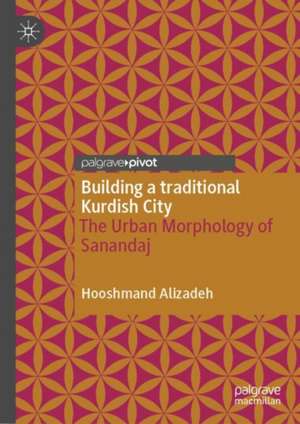Building a traditional Kurdish City: The Urban Morphology of Sanandaj
Autor Hooshmand Alizadehen Limba Engleză Hardback – 9 oct 2021
Preț: 455.30 lei
Nou
Puncte Express: 683
Preț estimativ în valută:
87.12€ • 91.29$ • 72.02£
87.12€ • 91.29$ • 72.02£
Carte tipărită la comandă
Livrare economică 11-25 aprilie
Preluare comenzi: 021 569.72.76
Specificații
ISBN-13: 9789811636332
ISBN-10: 9811636338
Pagini: 148
Ilustrații: XVIII, 218 p. 44 illus., 21 illus. in color.
Dimensiuni: 148 x 210 mm
Greutate: 0.44 kg
Ediția:1st ed. 2021
Editura: Springer Nature Singapore
Colecția Palgrave Pivot
Locul publicării:Singapore, Singapore
ISBN-10: 9811636338
Pagini: 148
Ilustrații: XVIII, 218 p. 44 illus., 21 illus. in color.
Dimensiuni: 148 x 210 mm
Greutate: 0.44 kg
Ediția:1st ed. 2021
Editura: Springer Nature Singapore
Colecția Palgrave Pivot
Locul publicării:Singapore, Singapore
Cuprins
Chapter 1. Preamble.- Chapter 2. Historical Background.- Chapter 3. Morphological Components. – Chapter 4. Details Of Place Structure.- Chapter 5. Public Domain.- Chapter 6. Private Domain.- Chapter 7. Conclusion.
Notă biografică
Hooshmand Alizadeh (PhD in urban design, Newcastle University/UK, 2006), is associate professor at the Kurdistan Studies Institute, the University of Kurdistan and senior postdoc researcher at the Austrian Academy of Sciences. He has more than fifteen years’ teaching and research experience in Urban Studies, particularly regarding aspects of urbanism and public space. His primary scholarly achievement is the development of the concept of the Kurdish city and women’s spatial interactions and empowerment, based on a comparative study in different urban contexts.
Textul de pe ultima copertă
“This pioneering and penetrating study reveals the socio-spatial characteristics of a remarkable traditional Iranian Kurdish city within its Zagros mountains setting, illuminating aspects of Kurdish urbanism that deserve to be as well understood as those of the Iranian plateau”.
- - Stephen Kite, Emeritus Professor, Cardiff University, UK
"An astonishingly authentic and intimate, holistic case study of the environmental, social, political and urban development and transformations of the pre-20th century city of Sanandaj, Iran – by a distinguished scholar and planner”.
- - Nader Ardalan, Emeritus, Harvard University Graduate School of Design “This book introduces a significant city with a distinctive character and history at the heart of Iran’s Kurdish region. It is a welcome addition to the studies of Kurdish culture and Iranian urbanism, especially from the perspective of urban form and the organization of public and private spaces in the city”.
- - Ali Madanipour, Professor, Newcastle University, UK
This book will fill an important gap in the knowledge of Middle Eastern cities by reconstructing the historical process of Sanandaj's formation and development until the rise of modernization in Iran. It discusses the nature of Kurdish settlements and the interaction between the social and spatial forces that have conditioned the processes and patterns of city formation and development over time. It identifies distinctive aspects of Kurdish settlements, such as their extroverted connection with the landscape, and the fluent interplay between private and public realms in female experience, providing a foundation for further studies of other Kurdish cities in the region. It will be an excellent resource for students and researchers of urban studies, geography, social science, and Kurdish studies.
Hooshmand Alizadeh (PhD in urban design, Newcastle University/UK, 2006), is associate professor at the University of Kurdistan and senior postdoc researcher at the Austrian Academy of Sciences. He has more than fifteen years’ teaching and research experience in Urban Studies, particularly regarding aspects of urbanism and public space. His primary scholarly achievement is the development of the concept of the Kurdish city and women’s spatial interactions and empowerment, based on a comparative study in different urban contexts.
- - Stephen Kite, Emeritus Professor, Cardiff University, UK
"An astonishingly authentic and intimate, holistic case study of the environmental, social, political and urban development and transformations of the pre-20th century city of Sanandaj, Iran – by a distinguished scholar and planner”.
- - Nader Ardalan, Emeritus, Harvard University Graduate School of Design “This book introduces a significant city with a distinctive character and history at the heart of Iran’s Kurdish region. It is a welcome addition to the studies of Kurdish culture and Iranian urbanism, especially from the perspective of urban form and the organization of public and private spaces in the city”.
- - Ali Madanipour, Professor, Newcastle University, UK
This book will fill an important gap in the knowledge of Middle Eastern cities by reconstructing the historical process of Sanandaj's formation and development until the rise of modernization in Iran. It discusses the nature of Kurdish settlements and the interaction between the social and spatial forces that have conditioned the processes and patterns of city formation and development over time. It identifies distinctive aspects of Kurdish settlements, such as their extroverted connection with the landscape, and the fluent interplay between private and public realms in female experience, providing a foundation for further studies of other Kurdish cities in the region. It will be an excellent resource for students and researchers of urban studies, geography, social science, and Kurdish studies.
Hooshmand Alizadeh (PhD in urban design, Newcastle University/UK, 2006), is associate professor at the University of Kurdistan and senior postdoc researcher at the Austrian Academy of Sciences. He has more than fifteen years’ teaching and research experience in Urban Studies, particularly regarding aspects of urbanism and public space. His primary scholarly achievement is the development of the concept of the Kurdish city and women’s spatial interactions and empowerment, based on a comparative study in different urban contexts.
Caracteristici
Contributes to an understanding of the nature of Kurdish settlements Fills an important gap in the knowledge of Middle Eastern cities Provides a foundation for further studies of other Kurdish cities
